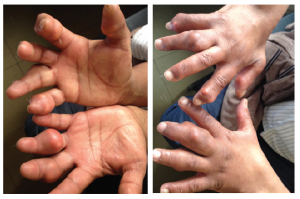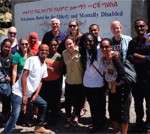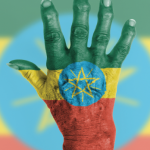
This patient with SLE presented to the Black Lion Nephrology Clinic with an old discoid rash.

This patient in the Black Lion rheumatology clinic had findings of tophaceous gout.
We listened to the residents and identified significant areas for improvement and created a plan to enact small changes at Black Lion Hospital. We doubled the number of rheumatology clinic days and taught residents such procedures as trigger finger steroid injections and arthrocentesis.
The rheumatology clinic was overwhelming for many residents. Four residents would see 20–25 patients in a span of three hours. Our observations during clinic days led us to realize there were gaps in practical management of rheumatic diseases and that residents were not comfortable increasing doses of methotrexate due to side effects. Through our RA lectures, we corrected misperceptions on starting doses of methotrexate and counseled about side effect monitoring. It was important to teach residents the difference between residual RA damage and active disease so they could determine when to start treatment. By working with them side by side during direct patient care, we taught residents how to complete a detailed musculoskeletal physical exam and how to detect joint activity.
To understand patient needs, we spent our first few days in the nephrology clinic—or attachment, as they call it in Ethiopia—during which time I saw many LN patients treated with cyclophosphamide staying in remission. These patients underwent treatment without having a kidney biopsy because patients had to pay for this procedure and many could not afford it. Clinical history and physical exam, as well as urine analysis with examination for active sedimentation, served as the primary means to diagnose LN. Because chronic ambulatory hemodialysis was not readily available, it was imperative to treat LN early. For many young Ethiopian women with LN who were planning to have a family, the decision to undergo cyclophosphamide, with the added infertility risks, was challenging. The supply of mycophenolate mofetil was variable. These patients underwent maintenance doses of cyclophosphamide and stayed in remission.
My experiences at Black Lion reminded me of my passion to help people & to solve complex multisystem problems.
Thanks to the close collaboration with the nephrology department at Black Lion, who predominantly manage patients with rheumatologic needs in addition to those with renal needs, we were able to surmount clinical challenges by minimizing overall cost to the patient. We saw many patients with CKD and gout, as well as with RA, in the nephrology attachment.



